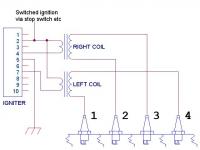...
Fred, you have confused me again. The side electrode is grounded as you said because it is on the part of the plug that is physically touching the engine. The engine is linked to the - or negative side of the battery. If the center electrode or core also has a negative voltage??? I am confused. I don't think the coil can create a more negative voltage, I would expect to see a positive voltage. Educate me please.
Remember on a wasted spark system one plug gets a positive ground, the other gets the negative ground.
On a single plug system, the manufacturer can choose which way the spark is on the single plug by the design of the coil; if you like he can take a wasted spark system and simply short one plug lead to ground to fire the other plug or visa versa.
(Click on image for larger view)

(Igniter pin numbers refer to my Trophy, but the rest is identical to the Gen I and Gen II FJRs.)
...
So why go with the smaller gap to begin with?
Because of the lower breakdown voltage, there is less stress on the insulation of everything else, in particular the coil and the plug leads, and in the "good old days" the distributer cap.
...
Does the coil atop the spark plug configuration provide a higher spark voltage than the two plug per coil circuit on the earlier FJR's?
...
The answer is No, because firing voltage is dependent on secondary circuit resistance.
The voltage has nothing to do with the resistance while no current is flowing. Even when current does flow, it's much more the inductance of the total circuit limiting the current. The voltage depends on the rate of change of current in the coil primary, the inductance of the coil, and the turns ratio of the primary to secondary of the coil. Where resistance does come into play is the primary coil resistance that limits the maximum current in the coil primary during the "contact closed" period, the higher this current the greater the rate of change of current when the contacts (or their electronic equivalent) are opened. Then we get into the higher engine speed scenarios when that primary current has little time to build up, then it is the coil's primary inductance that limits the current, and hence finally the possible voltage.
...
A waste spark system has to travel through 2 ignition wires and jump 2 plug gaps. That requires higher voltages than jumping a single gap and not traveling through any length of ignition wire, like Coil on Plug Systems.
...
Joe
Quite true, but even then it's not that simple.
The unused plug gap will ionise at a lower voltage because the gas pressure is lower. When this happens, as I tried to explain above, the voltage across this gap rapidly drops from its "breakdown" voltage to its "sustain" voltage. When this happens, the voltage difference instantly appears on the working plug gap, and this rapid rise in voltage makes for easier breakdown of the wanted spark.
Which reminds me, in my youth (many, many years ago), many people would put an extra spark gap in series with the spark plug because it would really give an improved spark performance at the plug. It was a case of cut the plug lead, strip a little insulation from the two ends, and wind the exposed wire ends through two opposite holes in a shirt button. This usually helped when the plugs were dirty (which was most of the time with our oil-breathing Triumphs, Nortons and BSAs).

































































